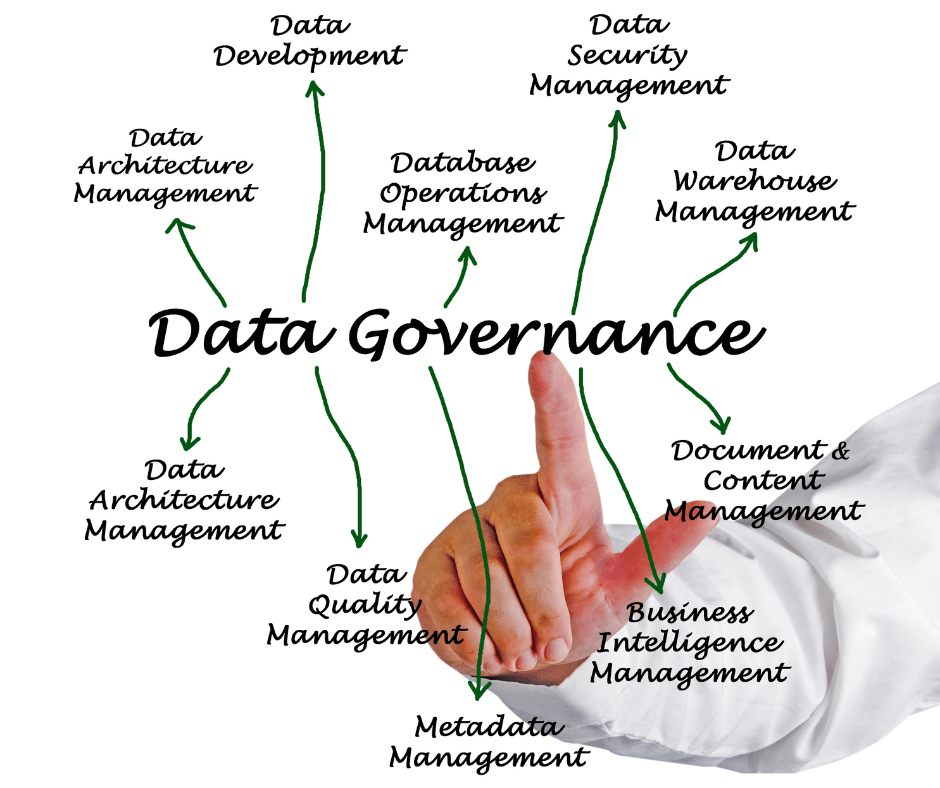Data governance is the code of conduct for data in an organization. Data governance is essential with every cloud investment considering the volume, the various types and sources of data, the numerous business and technical processes, and user profiles that create the data ecosystem. The business must have a data strategy and a data governance policy to achieve its goals.
Data governance is a set of rules, agreements, methods, policies, and leadership principles for optimizing data strategy and usage. It improves processes and their efficiencies, increases data quality and reliability, and produces a more valuable output. It also helps reduce and mitigate various risks at all levels of the organization and throughout the data lifecycle.
Businesses today have a vast amount of data captured in a way that is not intended for leveraging digital transformation technologies. In addition, there is a critical lack of data governance surrounding this information. It is reflected in poor data categorization, standardization, labeling, security, and lifecycle management; as a result, the data is more challenging to transform into valuable output.
Data governance prepares businesses for more advanced digitalization with process optimization, making way for process automation, analytics, and artificial intelligence.
SAP S/4HANA cloud provides a rich data ecosystem for intelligent enterprises. This technology pertains to every business defining its data governance rules and practices before, during, and after migration. Any organization that adopts all (or most) of these ten strategic guidelines can further develop its data governance approach for successful cloud migration and sustainable business transformation.
1. Create a Data Governance Leadership Team
Just as the most critical items are managed at the organization’s top, data – one of the most precious assets today – also requires innovative management and leadership. Data governance should address data for the entire organization, including every business unit and its collective interests. A transforming organization can be a battleground of conflicting interests and challenges, but many opportunities may arise in its contradictions. Outstanding leadership, data literacy, analysis, communication, business, and technical operations skills are necessary to achieve their stated goals. It is beneficial for the different business units to have a leader representing them within the data governance leadership team. The leadership team should be responsible for managing data as a continuous value chain.
2. Discard the Silo Operating Model
Silos (or compartmented operating models) in the business and the technology departments are unhelpful in achieving proper data governance. The digital age demands an open architecture that allows flexibility for data sharing across the organization’s business units while managing access and security risks. For better business intelligence and agility, information must be shared and accessible across the organization. This collaborative approach should not only happen in the infrastructure but also in the way of doing business.
3. Invest in Data Architecture and Processing Rules
The success of data analytics will depend on data structure, accessibility, and various other factors. Businesses should have their data architecture solidified and ready to conform to business needs and industry regulations. Define clear data migration policy and processes along with the architecture. Have information architects and their team define the necessary documentation, skills, and rules for better organizational data management, valuation, accessibility, and distribution.

4. Develop an Agile and Data-Driven Culture in the Organization
Create a data-driven culture where the organization views data as a primary business asset and a value chain. Develop data leveraging approaches, and make sure that the organization adopts and practices these processes daily. Invest in learning various data skills and technologies for the organization.
Consider soft skill enhancements of its workforce, including a review of cultural and behavioral habits. The organization should support new, healthier digital habits to create a new data-driven culture among its employees, collaborators, and suppliers. This process intends to shift the organization’s mindset to become agile, innovative, and collaborative.
The digital organization should constantly and quickly learn and adapt to internal and external changes while using these changes to drive innovation and business competitiveness. Starting with every business unit leader and manager, organizations should embrace the vision and mission of the greater collective and collaborate to support and achieve business goals.
When silos are broken, the organization can share information between departments; as a result, risks will be mitigated across the business units, the data value chain will increase, and digital maturity and agility will reach greater heights.
Imagine how unstoppable and competitive your organization could be if it reached peak data governance. Everyone becomes agile, understands the value of data, and has the skills, resources, knowledge, and attitude to process data, create innovative and rewarding assets and distribute it efficiently across the organization – all while practicing data security and privacy. Such an organization can quickly innovate and rapidly adjust its movement to respond to external changes and sync promptly. The advantages of an agile organization with data-driven culture are truly vast.
5. Invest in Data Skills and Technology for your Organization to Remain Current.
Data science is a new field with much of its future still to be written. Data skills are evolving fast, and it pays dividends for every organization to adapt its in-house data skills with multiple data professions, such as data scientists, statisticians, data architects, business analysts, DevOps, and more.
Consider the skills of external data sources such as suppliers and collaborators and create some requirements for collaboration. It is essential to communicate and align data standardization for better synchronization.
It is imperative to increase data literacy at all levels of the organization, especially regarding standardization, security, data capability, and evolution.
6. Define Data Quality, Standards, Methods, Policies, and Maturity Levels
Decide on a rating for data quality. Standardized data can be easily exploited to identify patterns and processes within digital data technologies. There is a need to define each level of data maturity, data qualifications, categorizations, attributes, type, labeling, level of importance, and sensitivity.
Have terms of reference for various documents, and be sure to keep it simple. Ensure that each detail you include is helpful and does not complicate things by discouraging adoption.
Remember to avoid conflicting policies. When working across teams, it is necessary to maintain the organization’s unity and not fragment it unnecessarily.
Depending on the organization, some policies to define include data security, approach to creating policies, classification, sharing, governance, analytics, data science, data protection, naming conventions, and versioning.
- Create inclusion, ownership, accountability, and momentum for continuous evolution:
- Receive approval from units and the data leadership team before implementing the policies.
- Get people involved and make their involvement decisive.
- Make the standards available and accessible, educate the organization about them and provide support for their everyday application and adoption.
- Designate at least one person for each unit (depending on your preference for division) for adoption.
- Consider a continuous review or re-evaluation period for certain key documents as things evolve in the business.

7. Comply with Audit and Security Regulations while Adopting Thorough Risk Management at all Levels
Decide on the obligatory compliance(s) for your company. Data compliance and responsible or accountable people should be decided at the top management level.
While discarding the practice of silo management is hugely beneficial, one of the very few areas where you need a siloed approach is risk management. Create risk assessments while considering the context or the area to achieve better risk management. In a house, for example, the risk pertinence differs whether the context is a kitchen, a bathroom, a bedroom, or a perched balcony. Similarly, it is wise to analyze and evaluate data risks in various contexts and situations and define rules, processes, and mitigating actions against threats.
Define the access control applied when sharing data across (and outside) the organization, the data exchange protocols, and the risks and contingencies of each. Sensitive data management should follow strict regulations and protocols. Invest in significant data security upfront because it is cheaper than managing a data breach disaster.
8. Invest in Data Transformation and Innovative Value Creation
Data transformation includes dashboard creation, analysis (both predictive and prescriptive), reporting, and the individual output you desire in a business unit context for data-driven decision-making. A data-driven decision is a precious investment and asset in your organization.
The best approach to getting optimal output from your data is to be result-driven. Dashboards are becoming tiresome and often routine, with little value derived from them – mainly because there has been a focus on fancy details with little value instead of the desired output. Leaders should focus on the desired outcomes before thinking of dashboards.
Some questions to consider for a result-driven approach to dashboard creation.
- What are the main outputs I want for my business units?
- What are the secondary outputs I want to achieve?
- What are these outputs made of?
- What are the KPIs?
- What KPI boundaries do I want to define that indicate a significant difference for me? (winning, need for improvement, warning levels)
Define effective methods and procedures for data transformation and output procedures. Don’t get lost in the details; focus on what matters and leave some flexibility for analysts.
9. Optimize Business Processes
When embarking on business process optimization, you are refining the quality and value of data in your organization, improving process effectiveness, delivery, and overall business efficiency. During this process, review data entry points, data structure and relevancy, needs for data refining, data content and process speed, storage procedures, process delays, output definition, data lifecycle, and archiving. The relevance and efficiency of each process (and sub-process) should be revisited regularly as developments evolve.
There is an absolute need for process ownership and having accountable people to monitor, improve and act as needed.
10. Invest in Employee Self-Transformation for Better Employee Engagement and Agility
Changes in personal habits require an individual approach. Regardless of the organization, some resistance is expected, even when not seen upfront. It would be best to prevent non-adoption by supporting individuals who continuously buy into data-driven culture and become more agile. It is easy for people to mimic what they perceive to be expected and immediately return to their previous habits; this result is unhelpful and will undo much of the organizational progress.
Facilitating life-changing habits from an individual level within the whole organizational ecosystem is necessary for sustainable transformation and digital maturity.
Leaders should also identify the “why” of any non-adoption to solve issues effectively. Two-way communication on various levels is essential; investing in our people is one of the most strategic ways to adopt a sustainable data-driven culture and achieve organizational success.










